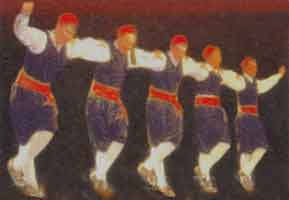.
The Hasapiko (Greek: χασάπικο Greek pronunciation: [xaˈsapiko], is a Greek folk dance from Constantinople. The dance originated in the Middle Ages as a battle mime with swords performed by the Greek butchers guild, which adopted it from the military of Byzantine era.[1] In Constantinople during the Byzantine times, it was called in Greek Mακελλάρικος Xορός (Makellarikos Horos). Some Greeks, however, reserve the latter term only for the fast version of the dance.

The slow version of the dance is called χασάπικο βαρύ (hasapiko vary) or χασάπικος βαρύς (hasapikos varys) and generally employs a 4/4 tempo. The fast version of the dance uses a 2/4 rhythm. It is variously called γρήγορο χασάπικο, μακελλάριος χορός; χασαποσέρβικο (grigoro hasapiko, makellarios horos, hasaposerviko – the latter a reference to Serbian and other Balkan influences on this version of the dance).
Hasapiko served as one of the bases for the Sirtaki.
See also
Greek dances
Sirtaki
Kalamatianos
Syrtos
References
^ sword dance in Encyclopædia Britannica. Retrieved July 18, 2010, from Encyclopædia Britannica Online: http://www.search.eb.com.proxy-um.researchport.umd.edu/eb/article-9070677
| Ancient Greece
Science, Technology , Medicine , Warfare, , Biographies , Life , Cities/Places/Maps , Arts , Literature , Philosophy ,Olympics, Mythology , History , Images Medieval Greece / Byzantine Empire Science, Technology, Arts, , Warfare , Literature, Biographies, Icons, History Modern Greece Cities, Islands, Regions, Fauna/Flora ,Biographies , History , Warfare, Science/Technology, Literature, Music , Arts , Film/Actors , Sport , Fashion --- |
Retrieved from "http://en.wikipedia.org/"
All text is available under the terms of the GNU Free Documentation License

